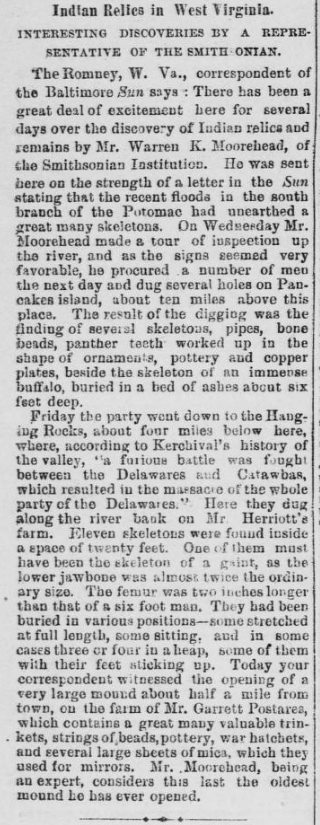Skeleton of a giant, Romney
Indian Relics in West Virginia.
INTERESTING DISCOVERIES BY A REPRESENTATIVE OF THE SMITHSONIAN.
“Indian Relics in West Virginia.
INTERESTING DISCOVERIES BY A REPRESENTATIVE OF THE SMITHSONIAN.
The Romney, W. Va., correspondent of the Baltimore Sun says: There has been a great deal of excitement here for several days over the discovery of Indian relics and remains by Mr. Warren K. Moorehead, of the Smithsonian Institution. He was sent here on the strength of a letter in the Sun stating that the recent floods in the south branch of the Potomac had unearthed a great many skeletons. On Wednesday Mr. Moorehead made a tour of inspection up the river, and as the signs seemed very favorable, he procured a number of men the next day and dug several holes on Pancakes island, about ten miles above this place. The result of the digging was the finding of several skeletons, pipes, bone beads, panther teeth worked up in the shape of ornaments, pottery and copper plates, beside the skeleton of an immense buffalo, buried in a bed of ashes about six feet deep.
Friday the party went down to the Hanging Rocks, about four miles below here, where, according to Kerchival’s history of the valley, “a furious battle was fought between the Delawares and Catawbas, which resulted in the massacre of the whole party of the Delawares.” Here they dug along the riverbank on Mr. Herriott’s farm. Eleven skeletons were found inside a space of twenty feet. One of them must have been the skeleton of a giant, as the lower jawbone was almost twice the ordinary size. The femur was two inches longer than that of a six-foot man. They had been buried in various positions-some stretched at full length, some sitting, and in some cases three or four in a heap, some of them with their feet sticking up.
Today, your correspondent witnessed the opening of a very large mound about half a mile from town, on the farm of Mr. Garrett Postares, which contains a great many valuable trinkets, strings of beads, pottery, war hatchets, and several large sheets of mica, which they used for mirrors. Mr. Moorehead, being an expert, considers this last the oldest mound he has ever opened.”.
The recent discovery of Indian relics and remains in West Virginia by Mr. Warren K. Moorehead of the Smithsonian Institution is a significant development in our understanding of history. The unearthing of several skeletons, pipes, bone beads, panther teeth worked up in the shape of ornaments, pottery, copper plates, and other valuable trinkets, including sheets of mica used as mirrors, provides invaluable insights into the existence and way of life of the ancient inhabitants of the region.
Of particular interest is the finding of eleven skeletons, one of which was that of a giant, with a lower jawbone almost twice the ordinary size, and a femur two inches longer than that of a six-foot man. These discoveries challenge our preconceived notions of what is possible and offer a glimpse into a world that was vastly different from our own.
Unfortunately, as with many discoveries that challenge mainstream views, there is a likelihood that there may be attempts to cover up or dismiss these findings. It is crucial that researchers like Mr. Moorehead continue their work, and their findings be thoroughly investigated, so that we can better understand the mysteries of our past. As a dedicated researcher, Mr. Moorehead’s work is commendable, and it is our hope that his findings will receive the attention they deserve. We owe it to ourselves to keep an open mind and to pursue the truth wherever it leads us.
Research done by Rephaim23
~Chris L Lesley/GAWMuseum


Comment